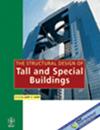具有结构偏心的高层建筑等效静风荷载的改进推导和全面理解
IF 1.3
3区 工程技术
Q3 CONSTRUCTION & BUILDING TECHNOLOGY
引用次数: 1
摘要
结构配置不规则的高层建筑的建造趋势导致建筑物具有复杂的外部风荷载以及质量和刚度中心之间的偏心,这使建筑物的三维等效静态风荷载(ESWL)的评估变得复杂。本文提出了一种改进的方法来确定具有结构偏心度的高层建筑的三维ESWL。首先,详细描述了每层基于三维内力的ESWL的推导过程,包括平均值、背景值和共振分量。然后,使用三个典型的高层建筑,每个建筑都有15种偏心情况,来证明所提出的方法在具有结构偏心的高层建筑的抗风设计中的优势,特别是在提供可靠的ESWL沿高度分布方面。最后,进行了系统分析,以检验荷载相关性、结构偏心率和建筑侧比对导出的三维ESWL的影响。结果表明,所提出的方法提供了可靠的沿高度分布,有助于充分了解具有结构偏心度的高层建筑的ESWL。从结果中提取了一些结论性意见,以说明荷载相关性、结构偏心率和建筑侧比如何影响高层建筑的ESWL。这些结论对结构偏心高层建筑的抗风设计具有一定的参考价值。本文章由计算机程序翻译,如有差异,请以英文原文为准。
An improved derivation and comprehensive understanding of the equivalent static wind loads of high‐rise buildings with structural eccentricities
The trend of constructing high‐rise buildings with irregular structural configurations results in buildings with complicated external wind loads and eccentricities between the mass and stiffness centers, which complicate the assessment of buildings' 3D equivalent static wind load (ESWL). This paper develops an improved method to determine the 3D ESWLs for high‐rise buildings with structural eccentricities. First, the derivation process of each floor's 3D internal force‐based ESWLs, including the mean, background, and resonant components, is described in detail. Then, three typical high‐rise buildings, each with 15 eccentricity cases, are used to demonstrate the proposed method's advantage in the wind resistance design of high‐rise buildings with structural eccentricities, especially in providing reliable along‐height distribution of ESWLs. Finally, systematic analyses are conducted to examine the effects of load‐correlation, structural eccentricity ratio, and building side ratio on the derived 3D ESWLs. The results show that the proposed method provides a reliable along‐height distribution, which helps give an adequate understanding of the ESWLs of high‐rise buildings with structural eccentricities. Some concluding remarks are extracted from the results to show how the load‐correlation, structural eccentricity ratio, and building side ratio affect the ESWLs of high‐rise buildings. The conclusions are valuable references for the wind‐resistant design of high‐rise buildings with structural eccentricities.
求助全文
通过发布文献求助,成功后即可免费获取论文全文。
去求助
来源期刊
CiteScore
5.30
自引率
4.20%
发文量
83
审稿时长
6-12 weeks
期刊介绍:
The Structural Design of Tall and Special Buildings provides structural engineers and contractors with a detailed written presentation of innovative structural engineering and construction practices for tall and special buildings. It also presents applied research on new materials or analysis methods that can directly benefit structural engineers involved in the design of tall and special buildings. The editor''s policy is to maintain a reasonable balance between papers from design engineers and from research workers so that the Journal will be useful to both groups. The problems in this field and their solutions are international in character and require a knowledge of several traditional disciplines and the Journal will reflect this.
The main subject of the Journal is the structural design and construction of tall and special buildings. The basic definition of a tall building, in the context of the Journal audience, is a structure that is equal to or greater than 50 meters (165 feet) in height, or 14 stories or greater. A special building is one with unique architectural or structural characteristics.
However, manuscripts dealing with chimneys, water towers, silos, cooling towers, and pools will generally not be considered for review. The journal will present papers on new innovative structural systems, materials and methods of analysis.

 求助内容:
求助内容: 应助结果提醒方式:
应助结果提醒方式:


